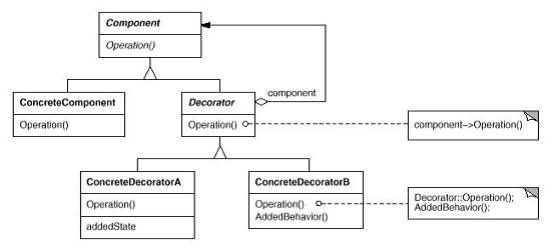设计模式 - Decorator模式(装饰模式)
Decorator模式的作用:
动态地给一个对象添加一些额外的职责。就像在墙上刷油漆。就增加功能来说,Decorator 模式相比生成子类更为灵活。Decorator常被翻译成"装饰",我觉得翻译成"油漆工"更形象点,油漆工(decorator)是用来刷油漆的,那么被刷油漆的对象我们称decoratee.这两种实体在Decorator模式中是必须的.
为什么使用Decorator?
刷油漆的对象我们称decoratee.这两种实体在Decorator模式中是必须的 我们通常可以使用继承来实现功能的拓展,如果这些需要拓展的功能的种类很繁多,那么势必生成很多子类,增加系统的复杂性,同时,使用继承实现功能拓展,我们必须可预见这些拓展功能,这些功能是编译时就确定了,是静态的。
使用Decorator的理由是:
这些功能需要由用户动态决定加入的方式和时机.Decorator提供了"即插即用"的方法,在运行期间决定何时增加何种功能.
UML结构图:

抽象基类:
1)Component:定义一个对象接口,可以为这个接口动态的添加职责。
2)Decorator:维持一个指向Component的指针,并且有一个和Component一致的接口函数。
接口函数:
1)Component::Operation:这个接口函数由Component声明,因此Component的派生类都需要实现,可以在这个接口函数的基础上给它动态添加职责。
解析:
Decorator的派生类可以为ConcreateComponent类的对象动态的添加职责,或者可以这么说:Decorator的派生类装饰ConcreateComponent类的对象.具体是这么实现的,首先初始化一个ConcreateComponent类的对象(被装饰者),采用这个对象去生成一个Decorator对象(装饰者),之后对Operation函数的调用则是对这Decorator对象成员函数的多态调用.这里的实现要点是Decorator类和ConcreateComponent类都继承自Component,从而两者的接口函数是一致的;其次,Decorator维护了一个指向Component的指针,从而可以实现对Component::Operation函数的动态调用。
实现代码:
 Decorator.h
Decorator.h 1 #ifndef DECORATOR_H
2 #define DECORATOR_H
3
4 // 抽象基类,定义一个对象接口,可以为这个接口动态的添加职责.
5 class Component
6 {
7 public:
8 Component(){}
9 virtual ~Component(){}
10
11 // 纯虚函数,由派生类实现
12 virtual void Operation() = 0;
13 };
14
15 // 抽象基类,维护一个指向Component对象的指针
16 class Decorator
17 : public Component
18 {
19 public:
20 Decorator(Component* pComponent) : m_pComponent(pComponent){}
21 virtual ~Decorator();
22
23 protected:
24 Component* m_pComponent;
25 };
26
27 // 派生自Component,在这里表示需要给它动态添加职责的类
28 class ConcreateComponent
29 : public Component
30 {
31 public:
32 ConcreateComponent(){}
33 virtual ~ConcreateComponent(){}
34
35 virtual void Operation();
36 };
37
38 // 派生自Decorator,这里代表为ConcreateComponent动态添加职责的类
39 class ConcreateDecorator
40 : public Decorator
41 {
42 public:
43 ConcreateDecorator(Component* pComponent) : Decorator(pComponent){}
44 virtual ~ConcreateDecorator(){}
45
46 virtual void Operation();
47
48 private:
49 void AddedBehavior();
50 };
51
52 #endif
53
2 #define DECORATOR_H
3
4 // 抽象基类,定义一个对象接口,可以为这个接口动态的添加职责.
5 class Component
6 {
7 public:
8 Component(){}
9 virtual ~Component(){}
10
11 // 纯虚函数,由派生类实现
12 virtual void Operation() = 0;
13 };
14
15 // 抽象基类,维护一个指向Component对象的指针
16 class Decorator
17 : public Component
18 {
19 public:
20 Decorator(Component* pComponent) : m_pComponent(pComponent){}
21 virtual ~Decorator();
22
23 protected:
24 Component* m_pComponent;
25 };
26
27 // 派生自Component,在这里表示需要给它动态添加职责的类
28 class ConcreateComponent
29 : public Component
30 {
31 public:
32 ConcreateComponent(){}
33 virtual ~ConcreateComponent(){}
34
35 virtual void Operation();
36 };
37
38 // 派生自Decorator,这里代表为ConcreateComponent动态添加职责的类
39 class ConcreateDecorator
40 : public Decorator
41 {
42 public:
43 ConcreateDecorator(Component* pComponent) : Decorator(pComponent){}
44 virtual ~ConcreateDecorator(){}
45
46 virtual void Operation();
47
48 private:
49 void AddedBehavior();
50 };
51
52 #endif
53
 Decorator.cpp
Decorator.cpp 1
2 #include "Decorator.h"
3 #include <iostream>
4
5 Decorator::~Decorator()
6 {
7 delete m_pComponent;
8 m_pComponent = NULL;
9 }
10
11 void ConcreateComponent::Operation()
12 {
13 std::cout << "Operation of ConcreateComponent\n";
14 }
15
16 void ConcreateDecorator::Operation()
17 {
18 m_pComponent->Operation();
19 AddedBehavior();
20 }
21
22 void ConcreateDecorator::AddedBehavior()
23 {
24 std::cout << "AddedBehavior of ConcreateDecorator\n";
25 }
26
2 #include "Decorator.h"
3 #include <iostream>
4
5 Decorator::~Decorator()
6 {
7 delete m_pComponent;
8 m_pComponent = NULL;
9 }
10
11 void ConcreateComponent::Operation()
12 {
13 std::cout << "Operation of ConcreateComponent\n";
14 }
15
16 void ConcreateDecorator::Operation()
17 {
18 m_pComponent->Operation();
19 AddedBehavior();
20 }
21
22 void ConcreateDecorator::AddedBehavior()
23 {
24 std::cout << "AddedBehavior of ConcreateDecorator\n";
25 }
26
 Main.cpp
Main.cpp 1
2 #include "Decorator.h"
3 #include <stdlib.h>
4
5 int main()
6 {
7 // 初始化一个Component对象
8 Component* pComponent = new ConcreateComponent();
9 // 采用这个Component对象去初始化一个Decorator对象,
10 // 这样就可以为这个Component对象动态添加职责
11 Decorator* pDecorator = new ConcreateDecorator(pComponent);
12
13 pDecorator->Operation();
14
15 delete pDecorator;
16
17 system("pause");
18
19 return 0;
20 }
21
2 #include "Decorator.h"
3 #include <stdlib.h>
4
5 int main()
6 {
7 // 初始化一个Component对象
8 Component* pComponent = new ConcreateComponent();
9 // 采用这个Component对象去初始化一个Decorator对象,
10 // 这样就可以为这个Component对象动态添加职责
11 Decorator* pDecorator = new ConcreateDecorator(pComponent);
12
13 pDecorator->Operation();
14
15 delete pDecorator;
16
17 system("pause");
18
19 return 0;
20 }
21




